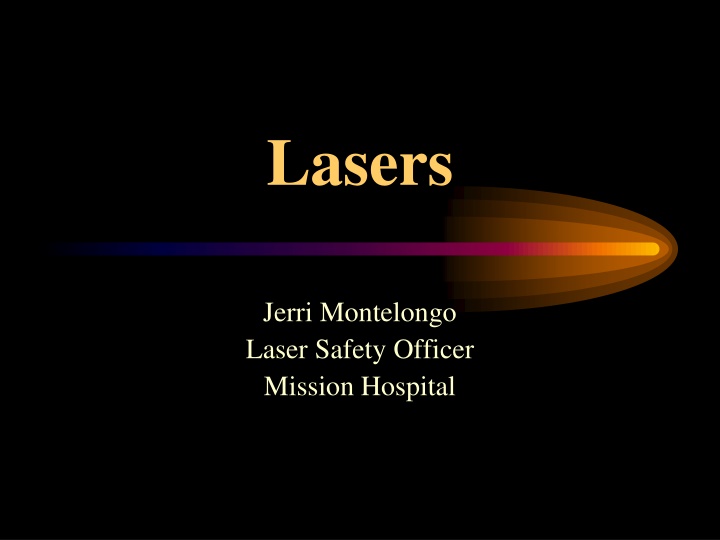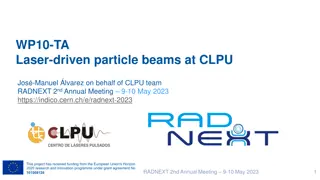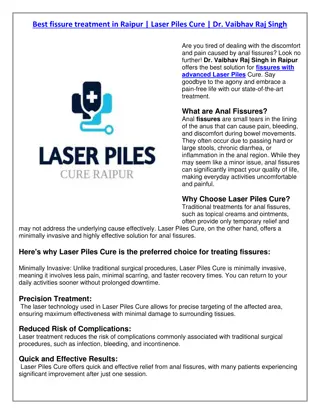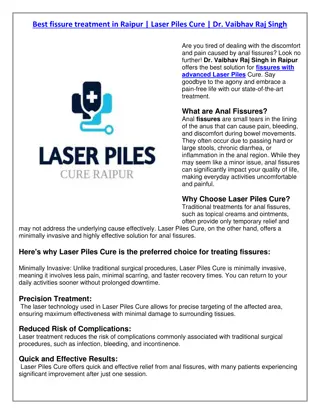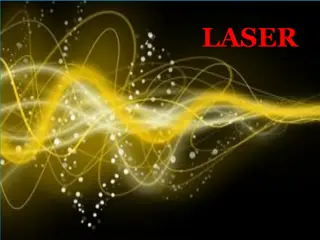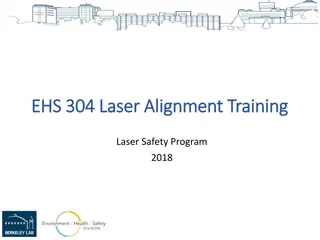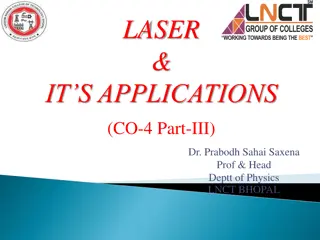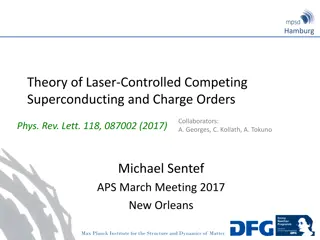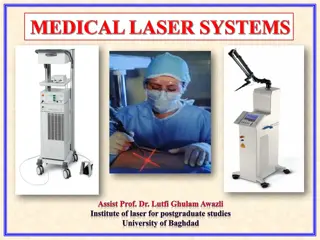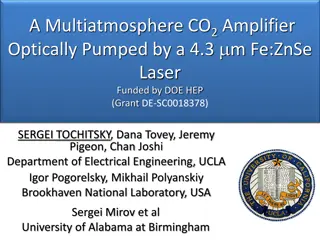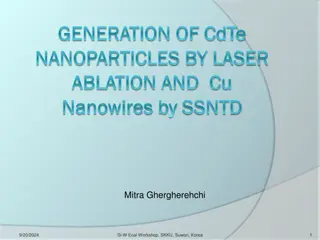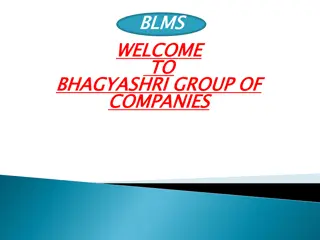Laser Technology and Applications
Laser technology plays a crucial role in various fields, including medicine, industry, and entertainment. Explore the characteristics of laser light, its effects on tissue, different types of lasing media, and usage across different sectors. Learn about the importance of laser safety measures and how factors like wavelength and delivery systems impact its applications.
Download Presentation

Please find below an Image/Link to download the presentation.
The content on the website is provided AS IS for your information and personal use only. It may not be sold, licensed, or shared on other websites without obtaining consent from the author.If you encounter any issues during the download, it is possible that the publisher has removed the file from their server.
You are allowed to download the files provided on this website for personal or commercial use, subject to the condition that they are used lawfully. All files are the property of their respective owners.
The content on the website is provided AS IS for your information and personal use only. It may not be sold, licensed, or shared on other websites without obtaining consent from the author.
E N D
Presentation Transcript
Lasers Jerri Montelongo Laser Safety Officer Mission Hospital
LASER Light Amplification by the Stimulated Emission of Radiation
Characteristics of Laser Light Collimated- tightly beamed Coherent- consistent waves Monochromatic- one color/spectrum
Lasers Effects on Tissue Absorbed Reflected Diffuse vs. Specular Transmitted
Other Factors that Influence Effects on Tissue Circulating blood supply Specific heat Thermal conductivity Color of tissue Chromophores: Melanin and Hemoglobin Delivery system
Electromagnetic Spectrum Visible 400-700nm Infrared 1000-11000nm Ultraviolet 150-350nm
Laser Uses Medical Commercial CD players Computer printers holograms Military Weapon sights Enemy detection Industrial Welding Cutting metal Sharpening edges
Types of Lasing Media Liquid Tunable Dye Solid Nd:Yag Ruby Gas Argon CO2
Argon Gas Visible and Ultraviolet spectrum 488 blue and 514 green Absorbed in hemoglobin and melanin Fiber delivery Orange glasses Ophthalmology--Retinopathy
Argon Argon produces blue and green light. Argon gas is visible, so no need for added laser to help aim. Can travel through clear fluids and tissues. Useful for the treatment of diabetic retinanopathy. Can also be used thrrough a cystoscope.
CO2 Carbon Dioxide- Gas 10,600 nm infrared Any tissue but not clear liquids Mirror/arm articulating delivery system Invisible so uses HeNe beam Clear Glasses GYN, ENT, Plastics
CO2 cont. The carbon dioxide laser (CO2 laser) was one of the earliest gas lasers to be developed. A helium- neon laser beam is transmitted with the CO2 to aid in aiming (CO2 is clear). Advantage precise cutting and coag due to absorption of the energy by the cellular water content. Not dependent on tissue color or consistency. Not to be used if laser needs to be transmitted through clear fluids. Most frequently used laser in the OR.
Krypton Gas 568nm Yellow, 647nm and 676nm red Blue-green is possible but not commonly used due to weakness of beam. Argon is preferred Color dependent, absorbed by darker pigments Free Beam Glasses are red for 568nm and Blue for 647 and 676 Plastics and Dermatology: Age spots, veins
Krypton Krypton is gas laser. Requires a water cooling system. Comes in red, green and yellow. Red is most frequently used. Eye surgeons use this on the retina.
Excimer 193nm, 248nm, 308nm, 351nm Ultraviolet- Gas Cold laser because it does not produce heat that can harm surrounding tissue Pink and Amber glasses LASIK and PRK , Also used in angioplasty
Excimer Excimer Uses gas and halogen as an active medium. Beam is ultraviolet. Used to reshape the cornea. Very exact cutting/coag. Disadvantage - Gases are fatal to humans and exposes humans to ultraviolet light.
Holmium YAG 2100-2140nm Infrared Absorbed in water Pulsing allows delivery Tears tissue by mechanical destruction Fiber delivery Gray Glasses Urology, Ortho
Holmium: YAG Holmium: YAG pulse beam, travels through a flexible fiber. Tip of the fiber held less than 5mm from tissue. Can also be transmitted through clear fluids. Has special electrical needs such as 208-volt service.
Nd: YAG Neodymium: Yttrium Aluminum Garnet Solid 1064nm- infrared Invisible, uses HeNe beam High Absorption in tissue protein Coagulation Fiber or free beam Transmissible through fluid Light yellow, green and brown glasses GI bleeds and tumors, vein treatment, hair removal also used in Neuro for tumors and disks, Endometrial ablation
Nd: YAG Neodymium:yttrium-aluminum-garnet - A helium-neon laser beam is also transmitted to aid in aiming. Absorbed by darker tissues. Beam can be transmitted through clear fluids this is a major advantage. Used on bladder tumors, prostatectomies, etc. (also the laser of choice for gastrointestinal endoscopy)
PTP/KTP Potassium Titanyl Phosphate K is potassium on periodic table 532nm Visible green, solid Absorbed in hemoglobin and melanin Intermediate tissue penetration Cuts on contact coagulates non contact Fiber Transmissible through fluid Orange glasses Urology
Potassium titanyl phosphate (KTiOPO4) Potassium titanyl phosphate (KTiOPO4) KTP laser - produces a green wavelength with an affinity for red or darker tissues, such as hemoglobin or melanin. Used to produce "greenlight" to perform some laser prostate surgery.
Ruby 694nm Solid state, visible light Blue and blue-green glasses High energy pulses selectively vaporize tissue Plastics and dermatology
Tunable Dye 400-900nm continuous wave Gas, liquid, and solid state Multi-tuning wavelengths Blue to Violet glasses Dermatology, urology, ophthalmology, Plastics
Laser Classifications Lasers are classified based upon the hazard it presents. Each classification has a standard set of control measures Class I- no hazard Class II- Aversion response/Blinking will prevent injury Class IIIa- blinking can prevent injury unless viewed directly with collecting optics Class IIIb-beam and reflection can harm if looked at directly including intra-beam viewing of specular reflections Class IV- extreme hazard to eyes and skin
Laser Hazards Tissue Injury Accidental firing and not using safety precautions Skin Burns and Eye damage Fire Sources of ignition Your role Preventing Fire Electrical Shock
Effects on Eye Band Wavelength Eye Structure Ultraviolet-A&B 200-315nm Corneal Burn Ultraviolet-C 315-400nm Photochemical Cataract Visible 400-780nm Photochemical and Thermal Retinal injury Cataract, Retinal Burn Infrared-A 780-1400nm Infrared-B 1400-3000nm Corneal Burn, Aqueous Flare, possibly Cataract Corneal Burn Infrared-C 3000-10600nm
Fire Drapes/Fabrics Hair Gases Plastics Prep Agents
Laser Safety Eye Protection Laser Specific lens/color related to laser Importance of eyewear Skin Protection Precautions for employee Precautions for pt Airway Protection Laser Specific Masks ET tubes Environmental Signs Fire Prevention measures Prep Solutions Drapes
Laser Wavelength EMS Glasses Eyewear Table FIR Gas 193, 488 & 514nm Argon Visible to FUV Gas Orange CO2 10,600 Cutting, Coagulation and Vaporization Not through Clear liquids Clear 548, 647, 676nm Krypton Visible Gas Blue 193, 248, 308, 351, 364nm Excimer UV Gas Pink , Amber Holmium: YAG 2100-2140nm IR Solid Not through clear liquids Gray Green, Light yellow, and Brown Nd:YAG 1064nm NIR Solid KTP/PTP 532nm IR Solid Orange Ruby 694nm Visible Solid Blue to Blue-green Tunable Dye 400-900nm Tunable Liquid Blue to Violet Free Electron Tunable Electron beam Variable according to Wavelength
Skin protection Keep body parts out of the beam path No petroleum products used near laser beams Wet drapes Clip hair Limit laser beam exposure time
Airway Protection Masks No green, white or Orange Do not double mask Smoke evacuators Field Suction Air Exchanges in OR
Environmental Controls Limited Room Access Signs Equipment Controls Beam enclosures Experienced Personnel operating and servicing lasers
Bottom Line Follow the signs Rely on guidance from Laser Operator, preceptors are not always correct Not sure about Glasses or Masks, ASK Always have saline or water on field
